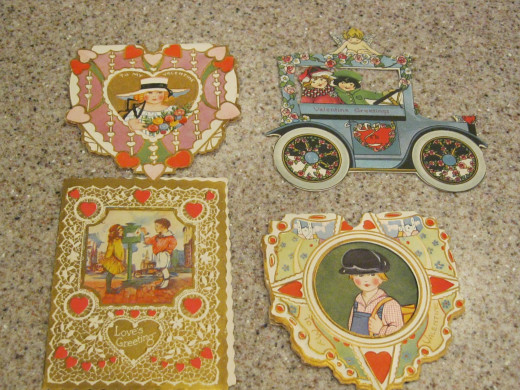Reasons to Collect Those Adorable Vintage Antique Valentines
A 1931 5 Dimensional Valentine

The History of the Valentine
With the increasing use of electronic communication from business to personal greetings, I predict that collectors of the future will seek and treasure the old fashioned bits of paper whether it be letters, calling cards, postcards or Greeting Cards. One of the most personal and socially interesting type of vintage cards is the Valentine. The excitement of making a Valentine box as a school girl in the 1950s, choosing Valentines for classmates, your teacher and other friends, and then opening the Valentines that you received brings back good memories. Later came the giggles of having received a Valentine from your first crush, or the disappointment that you didn't receive an expected Valentine. Much later came the truly romantic Valentines and the sweet Valentines sent by special family members and friends. Some of these Valentines were handmade, others had been carefully selected. Some included a personal message and were signed with xxxs and ooos for hugs and kisses; while others may have included a candy heart or two. While I understand the virtues of getting rid of clutter, I have to say, God bless the savers of the earth who have tucked away the little treasures from the past.
The celebration of Valentine's Day is attributed to a priest named Valentinus who was jailed during the Roman Empire for performing Christian weddings and other early Christian ceremonies. According to various legends, Valentinus was said to have healed the jailer's daughter and shortly before his execution, he sent a farewell note to her and signed it, "From your Valentine." His death and burial was said to have been on February 14th, although many historians agree that very few facts are actually known about Valentinus. Later, poets such as Geoffrey Chaucer are credited with the traditions of romantic or courtly love as outlined in flowery or romantic verses. By the beginning of the 19th Century, the sending of penny postcards with the symbols of hearts, cupids, roses, and turtle doves had become popular.
2 American Made 1930s Valentines

Late 1930s School Valentines

Postal Service Changed Valentines
Previous to 1900, most Victorian Valentines were large, and many had actual ribbons and actual lace and were handed or left to by found by the recipient of the Valentine. Most were given in a romantic context, and some in friendship. The advent of the mass printed postcard, and the penny postcard stamp to mail the card, changed Valentines from hand produced and hand delivered. So many of the beautiful Valentine postcards were printed in Europe by companies like Raphael Tuck, Paul Finkenrath and John Winsch and are widely available to collect. Most are priced under $8.00 and an avid antiques collector can often find Valentine postcards for less, depending upon the image, the publisher and of course the condition.
During the 1920s and 1930s Valentines continued to honor romantic love, but Children's Valentines with images of cute children and verses intended for children became popular. World Wars One and Two changed the Valentines that Americans purchased to American made postcards and Valentines. Many Valentines of the 1930s and 1940s have add-ons of crepe paper flowers or a ribbon. Many traditional Valentines have real or printed lace. The symbol of the lace comes from the Latin word "laques" meaning to net or capture, as meant to capture a heart. Some had pop-ups inside, or parts which folded out. Some were produced as advertising or featured political or other well-known persons of the day, and these Valentines command high prices. There are two good reference books for collectors: One Hundred Years of Valentines by Katherine Kreider and Valentines A Collectors Guide 1700-1950 by Barbara Johnson to help with identification of age and values.
One type of Valentine, which I don't collect is the Vinegar Valentine which was usually printed with an exaggerated caricature and a mean verse which was intended to insult the recipient. The vinegar Valentines often poked fun at the recipient's exaggerated physical feature such as their nose, ears, mouth, weight or some personality trait. These were usually non-colorful "tear sheet" Valentines printed on cheap newspaper type papers and sometimes vinegar Valentines were called "Penny Dreadfuls". The heyday of the vinegar Valentine seems to be from 1905 through the 1940s. A great aunt of mine had received one from a school mate and she hated Valentine's Day ever after that.
When mailing Valentine cards became common, Valentines included envelopes. Valentines intended for school children were sold in a boxed set and included a Valentine for the teacher. School Valentines from the 1950s, 60s, 70s and 80s are plentiful and a collector can usually purchase these Valentines for $2.00 or less. Some exceptions are the cartoon character Valentines such as Muppets, other popular TV characters or Disney produced Valentines.
Most vintage Valentines have been used; however, if the card is cute and in good condition, I cross out the name of the former sender and I add mine, and send it to someone who loves vintage items. Also, I have used vintage Valentines in table decorations and as place cards.
Valentines being produced today range from romantic to the really gross, and there seems to be a specific Valentines for sweethearts, spouses, familiy members and friends. It is estimated that Valentine's Day is second only to Christmas for sending cards and that over one billion cards are sent on Valentine's Day each year. I love trying to guess which Valentines collectors might prize in the future.
1940s Cute Children Valentines

A Valentine for My Wife 1950s

© 2013 mactavers








